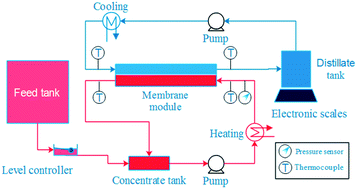Reverse osmosis brine treatment using direct contact membrane distillation (DCMD): effect of membrane characteristics on desalination performance and the wetting phenomenon†
Abstract
Hydrophobic polyvinylidene fluoride (PVDF) membranes with different average pore sizes (0.22, 1.00 and 5.00 μm) were used in direct contact membrane distillation (DCMD) to investigate the effect of the membrane properties on membrane flux, desalination performance and the wetting phenomenon in reverse osmosis (RO) brine treatment. The membranes used were systematically characterized with reference to contact angle, porosity, thickness, maximum pore sizes and liquid entry pressures (LEP). Moreover, the interfacial and morphological characteristics of new and used MD membranes were analyzed with respect to contact angle, scanning electron microscope (SEM) images and energy-dispersive X-ray spectroscopy (EDS) spectra. Although all the ion rejections of membranes with different pore sizes exceeded 99.95%, the conductivity of the distillate was much lower when the membrane with the smallest pore size was used. Regarding membrane flux and pore wetting, the pore size of the MD membrane was not observed to be a vital factor, whereas the porosity of the membrane was critical since it alters the flux. Besides, membrane wetting was found to be mainly influenced by salt scaling rather than pore size, allowing wetting of the MD membranes when the transmembrane pressure was far lower than the liquid entrance pressures of the membranes.



 Please wait while we load your content...
Please wait while we load your content...